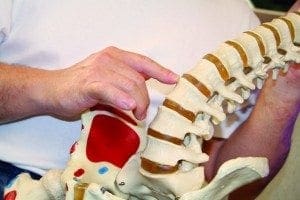The topic of pain is obviously a very broad one, however we often get patients asking: “Just how can chiropractic treatment get rid of my pain?” Since this is the most common symptom our patients present with (whether it be neck or back pain, headache pain, knee pain, elbow pain, etc), here’s a quick explanation of how chiropractic treatment affects pain.
There are 2 ways that chiropractic treatment can reduce pain:
- Peripherally (ie. at the site of the injury or dysfunction, where the pain is generated)
- Centrally (ie. at the spinal cord and/or in the brain, where the pain is registered and modulated)
1. Peripheral effects on pain
The exact mechanism of pain reduction at the actual site of an injury depends on the type of injury that has taken place. Various chiropractic techniques, however, are known to create changes in joint and muscle function such as decreasing restrictions, releasing entrapped tissues, enhancing blood flow and lymphatic drainage to the area of concern, stretching tight muscles, increasing mobility and so on.
The exact treatment application is tailored for each patient and their condition, however the mechanical changes created by our treatment will decrease the generation of pain signals from that particular site.
2. Central effects on pain
It is here that our approach to the treatment of pain really has the greatest effect. All pain is registered and ‘felt’ in the brain. Even though you feel pain at various sites of your body, it’s only because a set of neurological connections are stimulating the specific part of the sensory cortex in the brain that corresponds to that area. If the function of the brain (and spinal cord) is altered, the perception of pain will also be altered.
You can probably relate to this – when you hit your thumb with a hammer, or jam your finger in a drawer, what’s the natural response? We naturally shake our hand or rub the area. When we shake our hand vigorously, we create a lot of movement and joint position change – this movement fires a whole lot of sensory signals called proprioception (joint position sense) back to the spinal cord and into the brain. Proprioceptive signals are stronger and faster than nociceptive (pain) signals, and so when we increase proprioception we actually inhibit pain. This ‘pain blocking’ reaction takes place in the spinal cord, so effectively the pain signals that are trying to get into the spinal cord to travel back up to the brain aren’t allowed in (or are at least diminished) and the brain doesn’t receive those painful signals.
When we perform a chiropractic adjustment (particularly a spinal adjustment), the large populations of proprioceptors embedded in the joints and muscles of that area fire off and enter the spinal cord. This increased proprioceptive firing into the spinal cord has the same effect as the example mentioned above (shaking your hand vigorously), only much greater. This bombardment of proprioceptive signals that occurs when we give a spinal adjustment blocks nociceptive (pain) signals and creates a strong pain killing effect, and almost immediately provides a significant decrease in pain levels from that area. It’s this understanding of pain inhibition at the spinal cord that sets chiropractic apart from many treatment modalities.
We often utilise adjustments to other parts of the body to create the same proprioceptive bombardment effect at the spinal cord – eg. adjusting the foot and increasing proprioceptive signals from this area can have a strong effect on lower back pain, as the proprioceptive signals from the foot enter the spinal cord around the same level as pain signals from the lower back region.
Furthermore, a proprioceptive bombardment provided by a chiropractic adjustment will stimulate certain parts of the brain. One of the jobs of the brain is to modulate and suppress pain. A tired, underactive and fatigued brain doesn’t do this very well (which, incidentally, is why most things hurt more when you’re tired and fatigued, often at the end of the day). Stimulating the brain in this way will help it to modulate and inhibit pain better.
The proprioceptive circuits that get switched on following an adjustment will naturally fatigue over time, and the pain signals will be allowed to slowly take over again. This is why we need to provide repeat treatments to continue to activate these circuits and keep them building up. It’s a bit like going to the gym, only each time we do an adjustment we’re building up the strength of your neurological circuits. Once they’re strong and self-sufficient, pain is usually much less of a concern than it used to be.
Regardless of the type of injury you have or the source of the pain, chiropractic has a unique ability to act upon the local site of the injury as well as the central pain regulating mechanisms.
Chiropractic & Pain
1 in 5 Australians experience chronic pain at some stage in their lives, and it is estimated that chronic pain is the third most costly health problem in Australia.
Chronic pain is long-lasting, ongoing pain that doesn’t go away and affects the quality of life of those affected. It is estimated that 60-83% of Australian aged care residents are affected. Alarmingly, chronic pain is often seen as ‘normal’ part of ageing. It isn’t!
Chiropractors play a critical role in assisting people to live with chronic pain. Chiropractors work across the lifespan continuum assisting patients with their pain with the aim of;
- Diminishing pain
- Improving quality of life where possible
- Preventing acute and sub-acute painful conditions developing into chronic pain
Types of pain
Acute pain is generally accepted to be the pain associated with acute tissue damage. The damage may be due to an event such as an injury or surgery or an active disease process within the tissues. The pain is considered to be driven by peripheral factors responding to the tissue event. As tissue structure is re-established, the inflammation process resolves and tissue healing takes place, pain will also resolve. Pain in this situation provides an effective warning system, protecting vulnerable tissue, and is a symptom related to a distinct pathological condition or surgical procedure. When pain does not resolve it is relabelled persistent pain, or chronic pain. Pain lasting for longer than three months can be classified as chronic pain.
Sometimes, after the original source of pain is healed or no longer present, chronic pain patients may continue to feel pain. This can also lead to reduced mood or even depression and avoidance or fear of normal movement and activities. This can then lead to more pain. Pain that becomes chronic is often linked to changes in the nervous system, when tissues become highly sensitised, creating abnormal pain responses. Patients move less, or move in ways to protect themselves from more damage.
Where Chiropractic can help
- Spinal adjustment, to address chronic pain symptoms, such as inflammation and muscle tension
- Education about pain processes
- Mobilisation, trigger point therapy & nutritional advice
- Pain coping strategies so that you have effective tools to manage episodes of pain
- Re-education of normal posture and movement patterns
- Workplace assessment and addressing ergonomic factors
- Advice and education about how and which exercises can help
- Graded exercise programs – slowly increase exercise tolerance without the “boom-bust”
- Address movement behaviours that you may have developed that are not helpful
- Liaison with GPs, psychologists and specialists where required
Chiropractic treatment for chronic pain has a focus on empowering people to manage their conditions.
Chiropractic Pain Relief and Pain Management
When it comes to pain management and relief, Chiropractic care is a branch of healthcare that focuses on the relationship between the body’s structure – mainly the spine – and its function. Conditions commonly treated by chiropractors include back and neck pain, headaches, sports injuries and repetitive strains. Patients also seek treatment of pain associated with other conditions, such as arthritis.
Chiropractic is derived from Greek words meaning “done by hand.” In practice, this translates to Chiropractic adjustments of the spine and joints to help relieve pain and stiffness, improving the function of the associated nerves, joints and muscles.
Subluxations ( a misaligned vertebra) can cause inflammation and ultimately pain in nerves, joints and muscles. By manually adjusting vertebra, Chiropractors correct subluxations, restoring the nervous system to its optimal level.
Chiropractic treatments begin with a medical case history, orthopaedic and neurological evaluation and might conclude with adjustments to help realign the spine.
Scientific evidence proving that the chiropractic care works is overwhelming. Over the past 20 years, many controlled and independent research studies have shown again and again that chiropractic care is safe and effective for treating low back pain, neck pain, headaches and other conditions relating to the spine.


